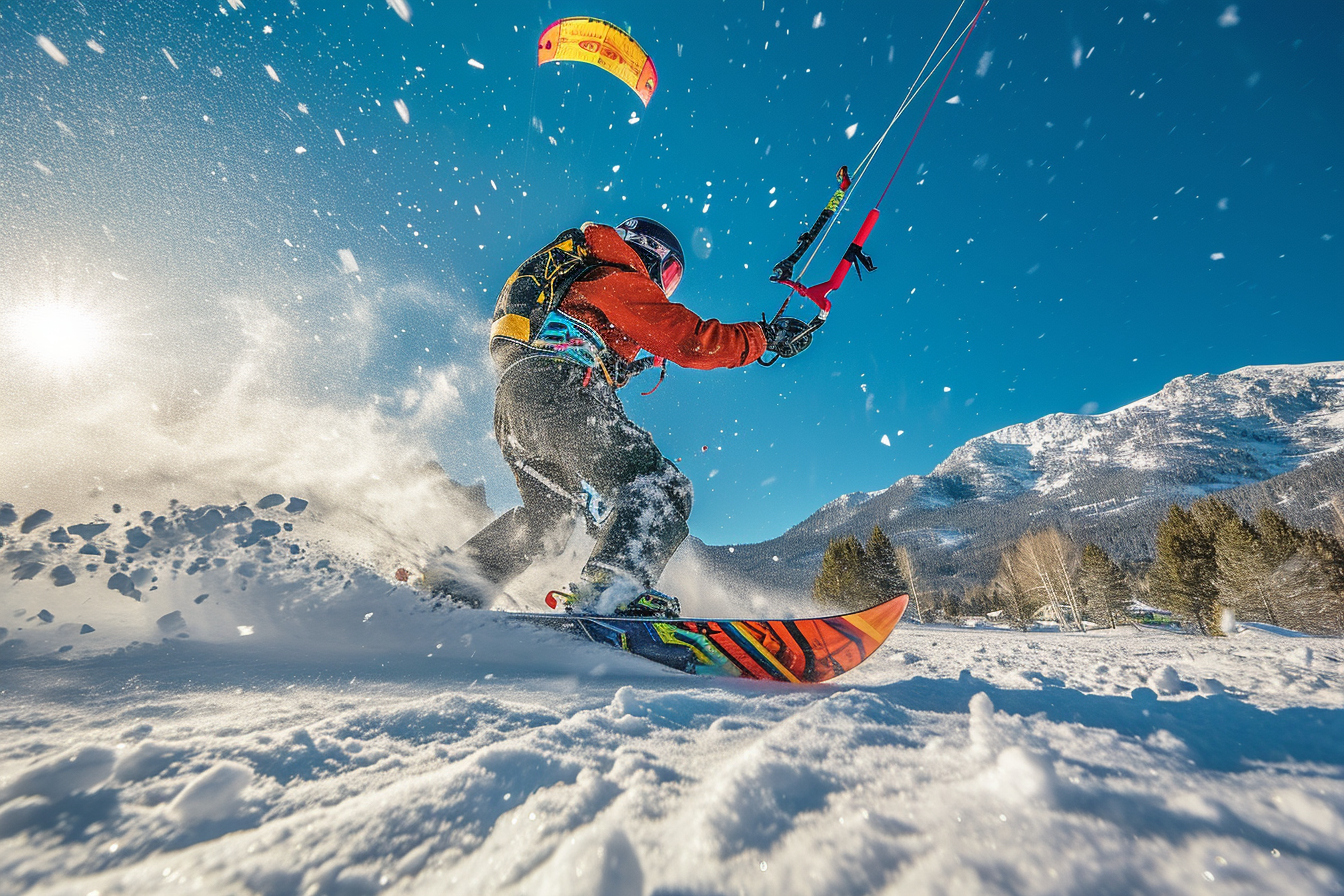
Kite surfing on snow, also known as snowkiting, presents an exhilarating blend of kite flying precision and winter sports excitement. It harnesses the power of the wind through a kite to glide across snow-covered terrain, offering an alternative to traditional skiing or snowboarding. For thrill-seekers and winter sports enthusiasts alike, mastering snowkiting can open up an entirely new world of adventure. This guide will lay the foundation for beginners to embark on this exciting journey, arming you with the knowledge and tips required for a successful start in the sport.
Understanding the basics of snowkiting
The equipment
Kites: The most essential piece of gear is the kite. It exists in different shapes and sizes, tailored to various skill levels and wind conditions. "Foil kites" are popular for their stability and ease of use in snow, while "inflatable kites" are common in water-based kiteboarding and can also be used on snow.
Bars and Lines: The control system includes a bar and multiple lines that connect to the kite. This setup allows you to maneuver the kite and control its power.
Harness: A harness wraps around your waist or seat, distributing the kite’s force and reducing strain on your arms.
Snowkiting Board or Skis: Depending on personal preference, you can use a snowboard or a pair of skis. Modifications are not typically necessary, meaning your standard winter gear often suffices.
Helmet and Safety Gear: A helmet is imperative for safety. Additional protective gear may include impact vests, knee pads, and back protectors.
The right conditions
Successful snowkiting depends on two primary factors: wind and terrain. Wind speeds between 8 to 20 mph are ideal for beginners, offering enough power without being overwhelming. Flat or gently rolling terrains such as frozen lakes or open fields serve as perfect practice grounds, minimizing the risks associated with steep slopes and obstacles.
Learning to fly the kite
Before strapping into your board or skis, dedicate ample time to learn how to fly the kite. Controlled takeoffs, flying steady, and landing are all foundational skills. Practice in an open area free of power lines and other hazards, ideally under the guidance of an experienced instructor.
Preparing yourself for the experience
Physical condition and skills
Physical fitness plays a vital role in managing the kite’s power and avoiding fatigue. Core strength, endurance, and flexibility improve control and reduce the risk of injuries. Previous experience in related sports, such as snowboarding or skiing, facilitates easier adaptation to snowkiting but is not mandatory.
Mindset and expectations
Set realistic expectations and be patient with your learning progress. Snowkiting requires practice to synchronize kite handling with boarding or skiing. Maintain a positive mindset, and allow yourself the time needed to learn and make mistakes.
Finding an instructor or school
Seeking instruction from a certified professional increases safety and accelerates the learning curve. An experienced instructor will provide personalized feedback and ensure proper technique, helping you to avoid bad habits that could hinder progression or compromise safety.
The initial training steps

Ground school
Your first hours will focus on understanding the wind window, equipment setup, and safety systems. A grassy or snowy field without obstacles is ideal for these initial lessons.
Kite control
Kite control is paramount in snowkiting. Grasping the basics on the ground allows you to develop muscle memory before introducing the complexities of riding on snow. You’ll learn to steer, manage power, and regain control after crashes.
Harnessing the wind
Understanding wind dynamics and power zones enables you to extract the optimal amount of power from your kite. Beginners start with smaller kites in moderate winds to ensure manageable conditions.
Safety protocols
Learning the correct use of safety releases and self-rescue techniques ensures you can effectively respond to unexpected situations. These protocols are essential for preventing injuries and protecting both yourself and others on the terrain.
Progressing to kite surfing on snow
Getting on your board or skis
Once comfortable with the kite on the ground, it’s time to add the complexity of the board or skis. Starting on level ground, you will learn how to balance the traction from the kite with the resistance of the snow.
Balancing and edging
Through gradual progression, you’ll refine your balancing and edging techniques, learning how to transfer the kite’s pull into forward momentum without slipping or losing control.
Stance and posture
Proper stance and posture are crucial for maintaining control and efficiency. Your instructor will help you find the sweet spot between comfort, balance, and power management.
Developing your skills
Upwind and downwind riding
Mastering the art of riding both upwind and downwind will significantly enhance your mobility on snow. It allows for traversing a variety of terrains and accessing new locations. Riding upwind involves angle and edge control, while downwind requires precise kite maneuvering.
Jumping and elevation
As you become more confident, you may start experimenting with jumps and other aerial maneuvers. Timing your jumps with the kite’s lift involves understanding the wind window and mastering kite control to achieve safe takeoffs and landings.
Improving speed and maneuverability
To increase your speed and sharpen your turns, you must refine your carving skills and kite positioning. Smooth, dynamic movements and anticipation of the kite’s behavior will lead to a more exhilarating and fluid ride.
Advanced techniques and challenges
Transitions and trick
Learning to change directions without losing speed, known as transitions, is an advanced skill that adds versatility to your snowkiting repertoire. Tricks, involving rotations and grabs, require a combination of kite control and board skills.
Backcountry adventures
Expand your horizons by venturing into the backcountry. This pursuit demands expert-level skills, an understanding of avalanche safety, and the ability to navigate unpredictable terrains and weather conditions. Always go with experienced partners and carry proper communication and safety equipment.
Ethical considerations and environmental impact
Respecting local regulations
Be aware of and adhere to local regulations for snowkiting. Not all areas permit kite sports, and certain locations may have specific rules to ensure everyone’s safety and enjoyment.
Environmental stewardship
As a snowkiter, it is your responsibility to minimize your impact on the environment. Stick to areas that are appropriate for the activity and take care to avoid disturbing wildlife or damaging vegetation.
Snowkiting offers a unique blend of freedom, excitement, and challenge. As you grow from novice to seasoned enthusiast, the sport continues to reveal deeper layers of complexity and reward. Embrace the community, participate in events, and continually seek to refine your skills. The path to mastery is ever-evolving, and each day on the snow brings new insights and experiences. As you progress, keep your passion for learning burning brightly, and relish the dance between the elements and your own abilities. Remember to always prioritize safety and respect for the environment as you enjoy this incredible journey across the winter landscape.


Leave a Reply